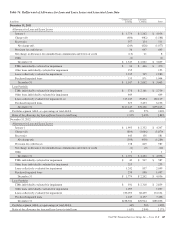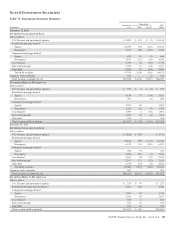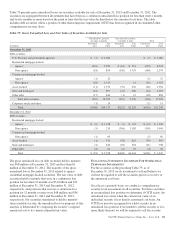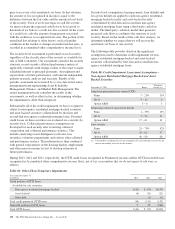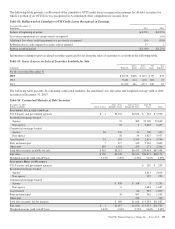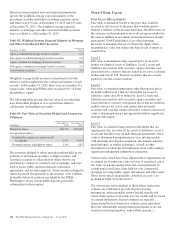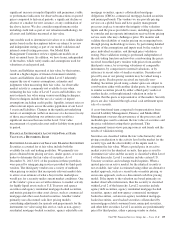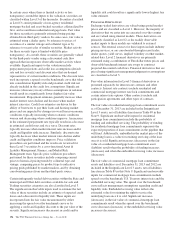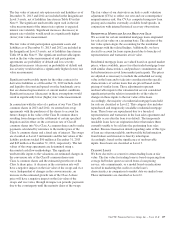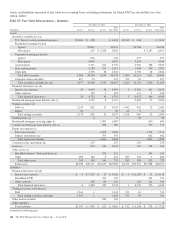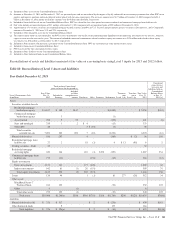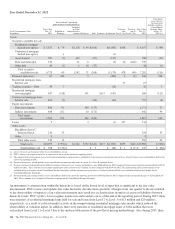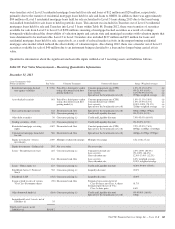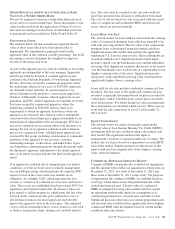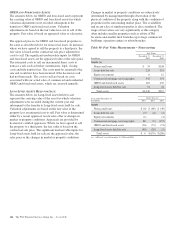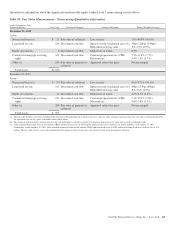PNC Bank 2013 Annual Report Download - page 175
Download and view the complete annual report
Please find page 175 of the 2013 PNC Bank annual report below. You can navigate through the pages in the report by either clicking on the pages listed below, or by using the keyword search tool below to find specific information within the annual report.The fair value of interest rate option assets and liabilities as of
December 31, 2013 and 2012 are included in the Insignificant
Level 3 assets, net of liabilities line item in Table 89 in this
Note 9. The significant unobservable input used in the fair
value measurement of the interest rate options is expected
interest rate volatility. Significant increases (decreases) in
interest rate volatility would result in a significantly higher
(lower) fair value measurement.
The fair value of risk participation agreement assets and
liabilities as of December 31, 2013 and 2012 are included in
the Insignificant Level 3 assets, net of liabilities line item in
Table 89 in this Note 9. The significant unobservable inputs
used in the fair value measurement of risk participation
agreements are probability of default and loss severity.
Significant increases (decreases) in probability of default and
loss severity would result in a significantly higher (lower) fair
value measurement.
Significant unobservable inputs for the other contracts for
derivative liabilities as of December 31, 2012 include credit
and liquidity discount and spread over the benchmark curve
that are deemed representative of current market conditions.
Significant increases (decreases) in these assumptions would
result in significantly lower (higher) fair value measurement.
In connection with the sales of a portion of our Visa Class B
common shares in 2013 and 2012, we entered into swap
agreements with the purchaser of the shares to account for
future changes in the value of the Class B common shares
resulting from changes in the settlement of certain specified
litigation and its effect on the conversion rate of Class B
common shares into Visa Class A common shares and to make
payments calculated by reference to the market price of the
Class A common shares and a fixed rate of interest. The swaps
are classified as Level 3 instruments and the fair values of the
liability positions totaled $90 million at December 31, 2013
and $43 million at December 31, 2012, respectively. The fair
values of the swap agreements are determined using a
discounted cash flow methodology. The significant
unobservable inputs to the valuations are estimated changes in
the conversion rate of the Class B common shares into
Class A common shares and the estimated growth rate of the
Class A share price. A decrease in the conversion rate will
have a negative impact on the fair value of the swaps and vice
versa. Independent of changes in the conversion rate, an
increase in the estimated growth rate of the Class A share
price will have a negative impact on the fair value of the
swaps and vice versa, through its impact on periodic payments
due to the counterparty until the maturity dates of the swaps.
The fair values of our derivatives include a credit valuation
adjustment (CVA) to reflect our own and our counterparties’
nonperformance risk. Our CVA is computed using new loan
pricing and considers externally available bond spreads, in
conjunction with internal historical recovery observations.
R
ESIDENTIAL
M
ORTGAGE
L
OANS
H
ELD FOR
S
ALE
We account for certain residential mortgage loans originated
for sale at fair value on a recurring basis. The election of the
fair value option aligns the accounting for the residential
mortgages with the related hedges. Additionally, we have
elected to account for loans repurchased due to breaches of
representations and warranties at fair value.
Residential mortgage loans are valued based on quoted market
prices, where available, prices for other traded mortgage loans
with similar characteristics, and purchase commitments and
bid information received from market participants. The prices
are adjusted as necessary to include the embedded servicing
value in the loans and to take into consideration the specific
characteristics of certain loans that are priced based on the
pricing of similar loans. These adjustments represent
unobservable inputs to the valuation but are not considered
significant given the relative insensitivity of the value to
changes in these inputs to the fair value of the loans.
Accordingly, the majority of residential mortgage loans held
for sale are classified as Level 2. This category also includes
repurchased and temporarily unsalable residential mortgage
loans. These loans are repurchased due to a breach of
representations and warranties in the loan sales agreement and
typically occur after the loan is in default. The temporarily
unsalable loans have an origination defect that makes them
currently unable to be sold into the performing loan sales
market. Because transaction details regarding sales of this type
of loan are often unavailable, unobservable bid information
from brokers and investors is heavily relied upon.
Accordingly, based on the significance of unobservable
inputs, these loans are classified as Level 3.
T
RADING
L
OANS
We have elected to account for certain trading loans at fair
value. The fair value for trading loans is based on pricing from
average bid broker quotes received from a loan pricing
service, sale commitments, or a model based on indications
received in marketing the credit or on the loan’s
characteristics in comparison to market data on similar loans.
These instruments are classified as Level 2.
The PNC Financial Services Group, Inc. – Form 10-K 157


